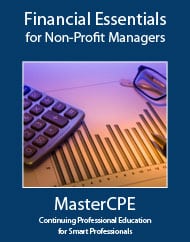Course Information
Financial Essentials for Nonprofit Managers
Course Information
| Title: | Financial Essentials for Nonprofit Managers |
|---|---|
| Category: | Finance |
| Field of Study: | Finance |
| Course Code: | M261 |
| CPE Credits: | 12.0 |
| Price: | 65.95 |
Description
Description:
Managers of nonprofit organizations (NPOs) generally are not skilled in financial matters. Or, managers may be preoccupied with its welfare objectives and fund raising and ignore the operations efficiency and operating cost controls. A series of appropriate questions that nonprofit financial managers must address in connection with an organization’s financial condition and activity include: 1. Do we have a profit or a loss? 2. Do we have sufficient reserves? 3. Are we liquid? 4. Do we have strong internal controls? 5. Are we operating efficiently? 6. Are we meeting our budget? 7. Are our programs valid? 8. Are we competing successfully? 9. Is our prioritizing of programs and activities reasonable? The course is an attempt to help answer these questions.
Delivery Method: Online Interactive Self Study
Level: Overview
Prerequisites: None
Advanced Preparation: None
Course Details
Category: Finance
Field of Study: Finance
Passing Score: 70%
Technical Details: Finance: Technical
For More Detail:
If you are unable to view PDF then right click the mouse and click save link as
Objectives
Objectives:
Chapter 1: Fundamentals for Nonprofits
- Recognize financing options for NPOs
- Identify different cost types and classifications for NPOs
- Recognize costs that are relevant to nonprofit decision making
Chapter 2: Accounting Concepts and Principles
- Recognize the accounting method used by NPOs
- Identify the processes of budget recording and accountability
- Distinguish between a contribution and an exchange transaction
- Distinguishing between conditional and unconditional contributions
Chapter 3: Cost-Volume-Revenue Analysis
- Identify the concepts answered by Cost-Volume-Revenue (CVR) analysis
- Differentiate among the methods to analyze financial statements
- Recognize components of the break‑even analysis
Chapter 4: Financial Statement Analysis and Performance Measurement
- Recognize different examples of trend analysis
- Identify objectives in analyzing the statement of activities and different performance measures
Chapter 5: Forecasting Methods
- Identify different examples of qualitative and quantitative forecasting methodology
Chapter 6: Budgeting Process
- Identify the various types of budgets
- Recognize the characteristics of different budgets and how to measure their effectiveness
Chapter 7: Efficiency and Cost Control
- Recognize the elements and characteristics of Zero Base Budgeting (ZBB)
- Identify the characteristics and the time considerations of program budgeting process
Chapter 8: Cost Predication and Performance Evaluation
- Identify how cost behavior and varianceanalysis can assist with the budgeting process
- Calculate different costs and variances for the budgeting process
Chapter 9: Management Control of Revenue and Expense
- Recognize use of mission centersand service centers for NPOs
- Identify the role of the contribution approach to cost allocation for measuring performance of responsibility centers.
- Recognize how cost allocations can affect performance metrics for managerial control
Chapter 10: Financing Techniques
- Calculate costs associated with different sources financing
- Estimate future NPO budgets based on past donations
- Differentiate between fixed, variable and semi-variable costs
- Calculate the cost of long-term debt financing
Chapter 11: Working Capital Technique
- Identify examples of the various cash models available
- Recognize costs that impact working capital
- Differentiate between investment objectives
- Identify different financial instruments available for investing surplus funds
Chapter 12: Cost Allocation
- Recognize the purpose for allocating service center costs to mission centers
- Differentiate among cost allocation techniques using the direct method, step-down (two-stage) method, and reciprocal method
- Identify the benefits of activity-based costing (ABC) and some factors that can be used in ABC
Chapter 13: Decision-Making Models
-
- Compute the present values and pay-back periods in a make or buy decision
- Identify different types of investment instruments and financial models
For More Objectives:
If you are unable to view PDF then right click the mouse and click save link as
Profession
NASBA: Yes
QAS: Yes
CPA: Suitable for all CPAs
IRS: No IRS credit for Enrolled Agents.
Profession Identifiers: CPA

